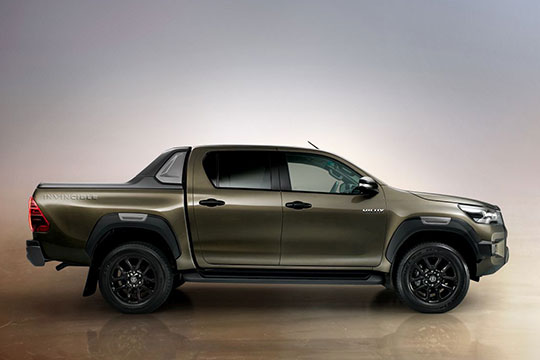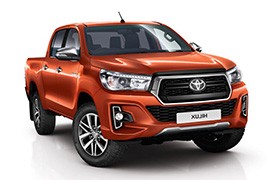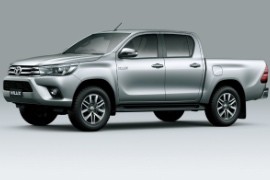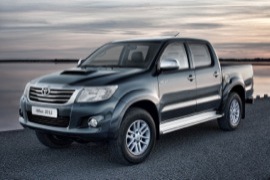TOYOTA Hilux Double Cab Models/Series Timeline, Specifications & Photos
First production year: 2011
Engines: Diesel, Gasoline
Body style: Truck
Toyota introduced a second refresh for the eighth generation of the Hilux in 2020, especially for European countries, where, among other design upgrades, it also introduced a more powerful engine.
While the world was locked down in their homes due to the pandemic, Toyota followed its plans of refreshing the Hilux range. It still offered the vehicle with a choice of three cab versions, with the Double Cab at the top. The refreshed model was updated on the exterior, where the most visual changes happened. In addition, the automaker didn’t forget to keep up with technology and introduced a few new improvements to the interior, making people happier, even if they had to pay some extra money to get them. At least these were available. However, the most significant improvement for European buyers was found under the hood, where they finally got the engine that Australians, Asians, and customers from Africa had.
At the front, the 2020 Toyota Hilux Double Cab had a redesigned fascia featuring a broad hexagonal grille with black accents and the chromed automaker’s badge. In addition, a satin chromed trim adorned the upper side of the front fascia. At the same time, two angular-shaped black slats went down towards the skid plate placed underneath the bumper. The automaker also added new scoops for the fog lamps.
From its profile, the 2020 Hilux Double Cab revealed its black trims mounted around the wheel arches, emphasizing the vehicle’s off-road character. A set of black side steps was available, creating a strong visual connection between the front and rear fenders. Toyota also reshaped the door mirror caps, which integrated the turn signal lamps. At the back, the car manufacturer installed a black trim for the tailgate handle that also integrated the rearview camera. A significant visual difference was found in the triangular taillights. They had the same overall shape but sported new rectangular lamps and used LED technology.
The 2020 Toyota Hilux Double Cab came with interior upgrades in the tech department. While the overall design of the dashboard was the same, the automaker offered a new eight-inch touchscreen infotainment system that supported wired Apple CarPlay and Android Auto. In addition, customers could use the integrated navigation unit if they didn’t want to use online programs such as Google Maps. Since customers used the Hilux as a sports truck for recreational use, Toyota offered the option of a powerful JBL sound system. Leather upholstery was still available, while base models still used fabric seating.
However, the most significant upgrade for European customers was the introduction of the 2.8-liter turbodiesel engine, which was previously reserved only for other markets due to emission regulations. Toyota managed to get it Euro 6d certified and made it available for the Old Continent. This version came to complement the already existing 2.4-liter turbodiesel. Both variants were paired with either a six-speed manual or a six-speed automatic, and the upper grades received an electronically controlled limited-slip rear differential.
Toyota tried to keep the sales figures up for the eighth generation of the HiLux and to achieve that, it introduced a refreshed version of the well-known pickup at the 2017 Thailand International Motor Expo.
The Japanese automaker was preparing a 2018 model year to celebrate the HiLux's 50th Anniversary, and customers loved the enhancements made by the car manufacturer to the 2018 Toyota Hilux Double Cab. Over the years, the well-known pickup went through significant transformations, morphing from a sport truck to a work truck without losing any of its off-road and loading capabilities. In addition, even though it was more comfortable and had similar amenities as an SUV, it was still perfectly capable of carrying heavy loads on top of a mountain, defying the laws of gravity, and conquering rough terrains with ease. However, there were still some areas that Toyota thought might be improved, starting with the exterior and continuing with the interior and the drivetrain.
At the front, the 2018 Toyota HiLux Double Cab retained its commanding look with wide and wedged-shaped headlights. Unlike the non-facelifted version, it featured chromed inserts, new Xenon bulbs, and L-shaped daytime running lights. The main grille between them was reshaped and had a shiny black finish, but the brand's chromed badge kept its shape and position. Another significant change was for the bumper, which featured a reversed trapezoidal-shaped air intake sporting a honeycomb pattern. In addition, it included standard fog lamps integrated into the side scoops that mimicked the shape of the headlamps.
From its profile, there were no significant changes. It had the same shape and proportions that made the eighth generation of the Toyota HiLux Double Cab a sales champion in its segment. However, customers could get the vehicle with shiny black door mirror caps and handles plus a dark set of side sills. At the back, the main differences were noticed on the bumper and on the tailgate's handle. The former had more dark areas, while the latter was completely black. But still, the triangular taillights remained the same.
Inside, the dashboard remained virtually the same as on its non-facelifted version, albeit with some minor upgrades. The instrument panel had new dials with white trim and orange needles instead of blue and gray ones as on its predecessor. However, the 4.6-inch color TFT display between the tachometer and speedometer was unchanged. The infotainment system on the 2018 Toyota HiLux Double Cab was also kept from its predecessor.
Under its skin, the 2018 Toyota HiLux Double Cab featured the same 2.4 or 2.8-liter turbodiesel engines paired with a six-speed automatic or a six-speed manual transmission. For selected markets, Toyota offered the pickup with a rear-wheel drive system only, but it used the same off-road-oriented chassis and suspension as the 4x4 versions. An unusual feature of the vehicle was the DPF switch. This could be used by drivers to manually initiate a cleansing burn of the soot captured by the filter after low-speed driving.
While the Single Cab and the Extra Cab versions of the eighth generation of the Hilux were created for specific activities, the Double Cab was the one that stole the show and the customers' wallets.
Toyota introduced the Hilux nameplate in 1968, and over the years, it became a respected nameplate in the industry, especially outside the U.S. Over the years, this Japanese pickup gained a reputation for its reliability and sturdiness. But it was never considered a family-oriented vehicle. It was suitable for a team of workers to go with their gear on top of a mountain or through harsh terrain. Still, its bland design, cheap-looking and rugged materials, and lack of amenities were not something a family would enjoy. As a result, along with the introduction of the seventh generation of the Hilux, the automaker started considering adding more SUV-inspired elements for the 2008 and 2011 facelifts. However, the most significant change occurred for the eighth generation of this nameplate, and the 2015 Toyota Hilux Double Cab became an alternative for a family vehicle.
The 2015 Toyota Hilux Double Cab was the star of the family and showed a front fascia resembling an SUV. Its wide headlights with wedged shapes and swept-back lines looked more dynamic and slightly aggressive. Furthermore, the automaker added daytime running lights with 12 LEDs, offering the car a distinctive look. The main grille sported two horizontal slats and the carmaker's chromed badge. Lower, on the bumper, the car manufacturer added a trapezoidal-shaped air intake flanked by a pair of scoops with available fog lamps.
From its profile, the 2015 Toyota Hilux Double Cab had more balanced proportions compared to its siblings. Its flared wheel arches and the full-size four-door cabin looked like they belonged to an SUV. Only the bed behind it reminded customers that it was a utility vehicle. In addition, the body-colored door mirrors with integrated turn signals and the available side steps transformed the pickup into a car that looked ready for any adventures with a family of five on board. At the back, the tailgate sported the third brake lamp at its upper side, flanked by a set of tall and triangular taillights.
Toyota tried to create a car-like interior for the 2015 Toyota Hilux Double Cab. The dashboard had curved lines and was available with a touchscreen display on the center stack for the infotainment system. At the same time, the instrument cluster was compact and featured two large dials for the speedometer and tachometer that flanked a 4.6-inch TFT display for the onboard computer. The front seats were high-mounted and flanked a center console that housed the gear stick (or the gear selector) and a few storage places. Next to it, on the center stack, Toyota installed a turning knob for the two-speed transfer box that switched from the rear to the 4x4 system and then to the low-range gear. In the back, the wide split-folding (40/60) bench seat concealed a storage compartment underneath it.
Under the skin, the 2015 Toyota Hilux Double Cab had an utterly new chassis that boasted 120 more welding points than its predecessor. The redesigned suspensions on both axles allowed for longer travel and smoother rides. Toyota also introduced two new engines: a 2.4-liter and a 2.8-liter unit, both turbodiesel. Standard transmission across the range was a six-speed manual, while a six-speed automatic was available for specific versions. In addition, the SR and the SR+ grades could be equipped with a locking rear differential.
Facing the effects of the world’s financial crisis that started in late 2007, Toyota understood that it wasn’t the proper time to replace the seventh generation of the Hilux, so in 2011, it introduced a second facelift for it.
In 2004, the Japanese car manufacturer launched the seventh generation of the Hilux, which it refreshed in 2008. But that wasn’t enough. Customers wanted something new, more potent, and more enjoyable to drive. It was an era where pickups became more appealing to private users who bought them to go camping or into the woods. The Hilux was also reckoned as one of the toughest, most reliable vehicles. However, it was the kind of vehicle that couldn’t perform too well on pavement. It was low on power and didn’t provide much comfort for its occupants. As a result, the automaker introduced the 2011 Toyota Hilux Double Cab, especially for those who wanted to use it for private use, not to take it on construction sites or other workplaces. In addition, the refreshed version carried over some of the ideas and technologies used by the automaker to make the Land Cruiser.
For the 2011 model year, the Hilux had a completely new front side. All body panels and bodywork elements were redesigned, from the bumper to the A-pillars. Its angular-shaped headlights, slightly swept back on the sides, resembled those of other vehicles from Toyota’s lineup. Furthermore, the three-slat grille, where the brand’s badge took center stage, was new. In addition, the bumper had a fresh look, with a reversed trapezoidal air intake flanked by a pair of scoops for the available fog lamps.
From its profile, the 2011 Toyota Hilux Double Cab revealed its new front fenders with shaved corners and rounded shape. The flared wheel arches made the vehicle look more rugged but also resembled those installed on the Land Cruiser. A pair of chromed metallic side steps were available depending on the grade. Toyota even offered the option for shiny door handles instead of the standard black ones. Furthermore, the SR and the SR+ grades came with turn signal lamps integrated into the door mirrors. Thanks to the four-door cabin and the wide opening for the rear doors, ingress and egress from the rear seats were easy despite the high ground clearance. At the back, the loading area was the shortest from the Hilux family. Still, it was good enough for any camping gear and outdoor activities. At the back, Toyota installed new clear taillights that flanked the tailgate, which sported the high-mounted third brake light.
Inside, Toyota installed a fresh dashboard featuring more horizontal lines to create the image of a wider cabin. Base versions had a simple stereo on top of the center stack, while upper grades got an infotainment system with sat-nav and rearview camera. Fronting the driver was a three-dial instrument cluster with a binocular-style where the speedometer took center stage and was flanked by the speedometer and the fuel level and temperature gauges. Toyota offered the car with standard cloth upholstery, while leather was on the options list. In the back, the flip-up bench seat was wide enough for three passengers. Power windows and locks on all four doors were available.
Under the hood, the 2011 Toyota Hilux Double Cab had a choice of two turbodiesel engines with 2.4 and 3.0-liter displacement paired as standard with a five-speed manual gearbox and two-speed transfer case that could send the power to the rear or to both axles. The more potent version was also available with a five-speed automatic. As an option, customers could also get the pickup a limited-slip rear differential, depending on the market



